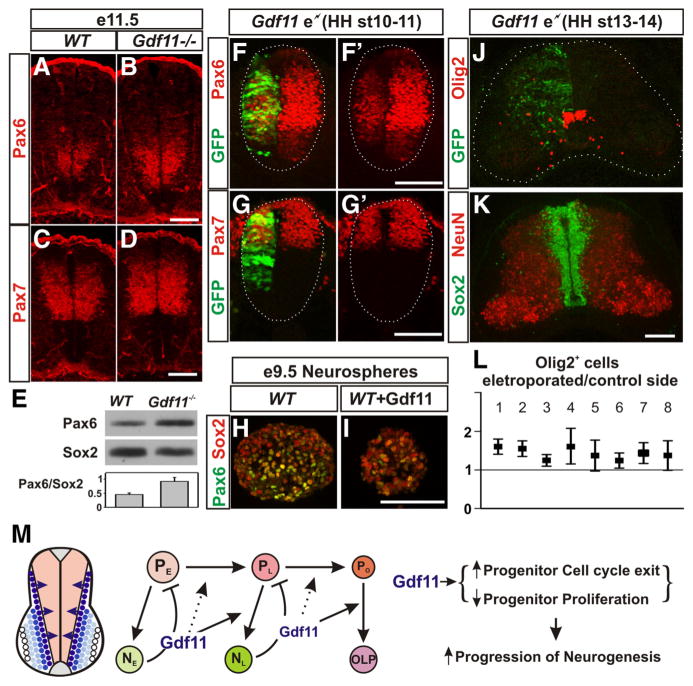Figure 7.
Gdf11 downregulates Pax6 expression. A–D, Pax6 (A, B) and Pax7 (C, D) expression in cross-sectioned brachial level spinal cord from e11.5 WT and Gdf11−/− embryos. Fewer Pax6+ cells with lower levels of Pax6 expression were observed in WT embryos (A) when compared to Gdf11−/− littermates (B). Pax7 expression is similar between WT (C) and Gdf11−/− embryos (D). E, Western analyses of brachial level spinal cord from e11.5 embryos revealed an ~2-fold difference in the Pax6 expression level in Sox2+ progenitors between Gdf11−/− and WT embryos. F–G′, Pax6 (F, F′) and Pax7 (G, G′) expression in cross-sectioned spinal cord from HH stage 17 chick embryos electroporated with a Gdf11 expression construct at HH stage 10 –11. White dotted lines delineate the margin of the spinal cord. The Pax6 level in the electroporated side (marked by GFP expression) is reduced significantly. H, I, Lower levels of Pax6 expression in e9.5 WT neurospheres cultured with 10 ng/ml Gdf11. J, K, Olig2 and GFP (J) and Sox2 and NeuN (K) expression in cross-sectioned brachial level spinal cord from e7 chick embryos harvested 5 d after Gdf11 electroporation at HH stage 13–14. The white dotted lines delineate the margin of the spinal cord in J. Scale bar, 100 μm in all images. L, Quantification of Olig2+ cells in the electroporated side compared to the control side of eight individual embryos (plots represent mean ±95% confidence to exhibit the degree of variability). Values above one indicate more Olig2+ cells are present in the electroporated side. M, A model for Gdf11 function in controlling the temporal progression of neurogenesis. Gdf11 is expressed transiently in the newly born neurons located lateral to the progenitor domains in the spinal cord. It acts as a feedback signal on neighboring progenitors to promote the transition from early progenitors (PE) that produce early born neurons (NE) to late progenitors (PL) that produce late-born neurons (NL), and to oligodendrocyte progenitors (PO) that produce oligodendrocyte precursors (OLP) by enhancing cell cycle exit and inhibiting progenitor proliferation. This results in facilitating the progression of neurogenesis in the developing spinal cord.

